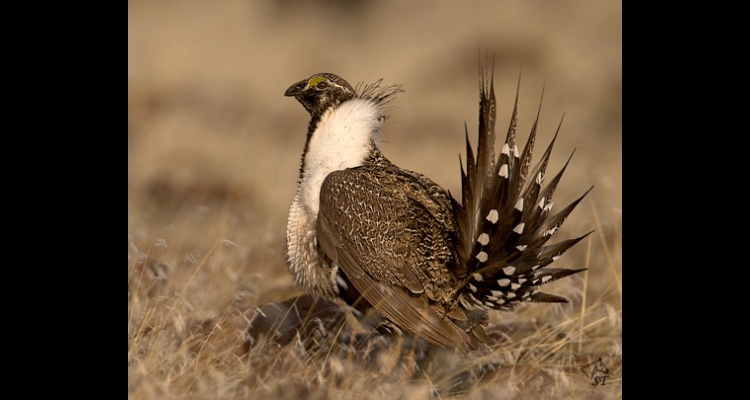Greater Sage-Grouse
Greater Sage-Grouse (Centrocercus urophasianus) are large, chicken-like birds found in sagebrush habitats in the western United States. They are the largest North American grouse—males weigh up to 7 lbs—and are known for the impressive aggregations of displaying males at traditional mating sites (leks.) Recently, the decline of these charismatic birds has been associated with the loss or degradation of sagebrush habitats.
Sage-grouse are grayish-brown with dark bellies and long, pointed tails. Males have black throats and white breasts, while females have white throats and grayish-brown breasts. Males are also about twenty-five percent longer than females and roughly twice as heavy.
These birds are closely associated with sagebrush species (genus Artemisia), which they require for food and cover. Unlike other chicken-like birds, they lack muscular gizzards for grinding hard items, so they must eat relatively soft foods. In winter they eat almost entirely sagebrush leaves. Breeding hens and chicks eat many non-woody plants and insects, and, in summer, hens may seek out relatively moist habitats that provide an abundance of these foods.
The species is found in the northern two thirds of Nevada and is most common in the northern and east-central parts of the state. Recent studies show that the population of sage-grouse found in Lyon County and adjacent eastern California is genetically distinct from all other populations of the species, although this population may not be distinct enough in other ways to warrant recognition as a separate species.
Greater Sage-Grouse mate on leks, which are open sites away from nesting areas where males congregate year after year to court females. Leks monitored in Nevada from 2000 to 2003 averaged fifteen males each, but the largest leks can have hundreds of males. As with other lekking species, Greater Sage-Grouse males do not provide any parental care; females mate on the lek and then leave to nest and raise the young on their own.
Male Sage-Grouse perform their striking displays on leks from late winter through spring, with most of the activity occurring around sunrise each day. In displaying, a male erects dark plumes on the top of his head, forms a fan with his long, pointed tail feathers (in the manner of a peacock) and inflates a pair of yellow air sacs, which protrude conspicuously through the breast feathers during the display. He then throws his head back rapidly while deflating the air sacs, producing a low-pitched "plopping" sound. Females choose mates based on several criteria, including the quality of the "plopping." A few males obtain almost all the mates, and most males on a lek never mate at all in a given year.
Before the late 1800s, Greater Sage-Grouse were much more widespread and abundant than they are now; for instance, a report from Wyoming in 1886 describes flights of thousands of sage-grouse, a description that would not apply anywhere today. In the last forty years, censuses at leks have documented an overall decline of about fifty percent. Sage-grouse numbers in Nevada have decreased over this period, although apparently not as drastically as for the species as a whole. The decline has been attributed to (1) habitat destruction by conversion to agricultural land; (2) habitat degradation due to grazing, human-caused changes in the frequency and intensity of fires and associated increases in invasive plants; and (3) hunting and poaching. For many people concerned with the preservation of natural environments, the decline of the Greater Sage-Grouse has come to symbolize the loss and degradation of sagebrush habitats.
In 2004, a collaboration of government agencies and other organizations produced detailed plans for the conservation of Sage-Grouse populations in Nevada and eastern California, to be carried out primarily at a local level. In 2005, after receiving three petitions to list the Greater Sage-Grouse as an endangered or threatened species, the U.S. Fish and Wildlife Service determined that the species does not warrant protection of this kind. This decision was considered a victory for ranchers, farmers, and oil and gas developers who have an economic interest in the use of lands occupied by Sage-Grouse and a defeat for environmentalists interested in protecting the birds and maintaining natural sagebrush habitats.
Article Locations
Related Articles
None at this time.
Further Reading
None at this time.
